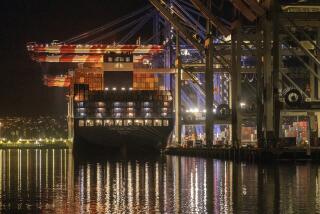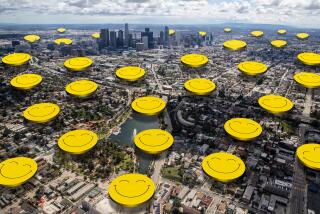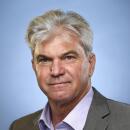Pinpoints on a Map of the Past and Future
- Share via
I have heard strange and wondrous tales of people who actually write down the names and telephone numbers of important contacts--not on the backs of torn envelopes--but on file cards or the pages of personal phone books, arranged in proper alphabetical order for ready access. There are also those, I am told, who maintain what are called “calendars” or “daybooks,” as opposed to scribbling appointments inside paperback covers or across random taxi receipts.
Alas, I do not run with such tribes. My custom is to chuck all varieties of work product into cardboard boxes kept at my feet, a system that can lead to long hours of struggling to find scraps of paper or to remember why I saved certain documents in the first place. For example: There must be a reason I stashed away the November 1994 edition of Backwoods Home magazine, but what is it? The primer on how to build log cabins? The cover piece on “barbecuing goats”?
A lack of organization can take its toll. From time to time, feeling smothered by clutter and confusion, I will come to work determined to get myself organized. That these bursts of resolve never last long is no reason to quit trying--which explains the new map of California now hanging on the office wall.
The map is peppered with yellow and blue stickpins. The pins represent places in California where I have gone for columns. Since I have been writing columns about California two times a week for nearly a decade, there will be many pins on the map when the project is finished--presuming, of course, it will be finished. The idea at work here is to remind myself where I have been, which in turn will help inform any decision on where to go next: Where to go next in California is a question that more or less dominates my working life.
It has been interesting on its own merits, however, this process of retracing a decade’s worth of travel, map dot by map dot. With almost every pin stick there comes a flash of memory--images, pieces of conversation, moments that never made it into columns and, most of all, people.
I stick a blue pin in the town of Paradise, a little town east of Chico, and I see Rick Crowder, a former delivery truck driver who performs these days as “Sourdough Slim, the Yodeling Cowboy Comic and Songster.” In my mind’s eye I see Crowder, not at his place outside Paradise, but in a part of San Francisco where tourists gather. This is the very first time he has pulled on his chaps, boots, vest and multi-gallon hat and taken his act into the streets. I imagine him clearing his throat, tapping a boot toe and beginning to yodel at the tourists. By such acts of courage are lives changed.
I trace a finger down into the Central Valley and place a pin on the country highway between Manteca and Escalon, where each summer several farm families operate fruit stands out of little plywood shacks. Here I can taste a peach on a 107-degree day in July. It is like no peach on sale in any supermarket. I remember I had asked the owner why so many people seemed willing to drive for miles to shop at her fruit stand. Her answer had been simply eloquent. She said nothing and just handed me a peach.
Up into the foothills to Coulterville, a Gold Rush town on California 49 that in the Gulf War gave up one of its sons, a young Marine named Thom Jenkins. As one of the first to fall, they had put his face on the cover of Time magazine. “War’s Real Cost,” the headline said. Jenkins had been killed, it later turned out, by so-called friendly fire.
And now I am seated in a coffee shop with the young man’s father, nervously picking at a hamburger while he addresses the subject of bitterness. “That bitterness is a deep, deep hole,” the father of the dead Marine says, in a flat voice I can still hear nine years later, “and I would not allow it.
“It’s a fatal life. I accept that.”
I move down into the Mojave Desert, sticking a pin near the town of Cima, where I again see bands of bikers in black leather as they roar into a little roadside cafe. This is in August, off-season for the desert, and the bikers wipe sweat from their pink faces with red bandannas and swat away flies. They all seem to be speaking Italian, these bikers. They have been all over the desert, thundering through the ghost towns, living out scenes in their own spaghetti Westerns.
And then Vista, Lancaster, Lebec and Wasco, Ballico, Farmersville, Madera and Tranquillity, up to Pelican Bay and down to Indio, where on an autumn afternoon in 1991 a prostitute, her voice rising, describes how ludicrous her life could seem, working Interstate 10 in the middle of the afternoon.
“I mean, it’s a highway, for God’s sake,” she fairly shouts. “‘We are walking down a highway and trying to look inconspicuous. Right.”
And Hollister, Cholame and Avila Beach, Piru, Madera and Mendocino, where on a Sunday afternoon shortly after the riots the locals had watched football and told bad Rodney King jokes, and Los Angeles never seemed so far away. All these spots on the map get pins, and there are many, many more. I figure by the time I am finished I will have marked more than 500 spots on the map.
What’s interesting, though, is this: For every pin I stick in the map, I seem to notice three or four places I have yet to go. Some of them sound quite fetching, in their own way. I’m talking about Yerma and Woody and Loraine, Fiddletown and Bootjack and Gazelle, Shingletown, Roops Fort, El Mirage, Mecca. . . .
More to Read
Sign up for The Wild
We’ll help you find the best places to hike, bike and run, as well as the perfect silent spots for meditation and yoga.
You may occasionally receive promotional content from the Los Angeles Times.







